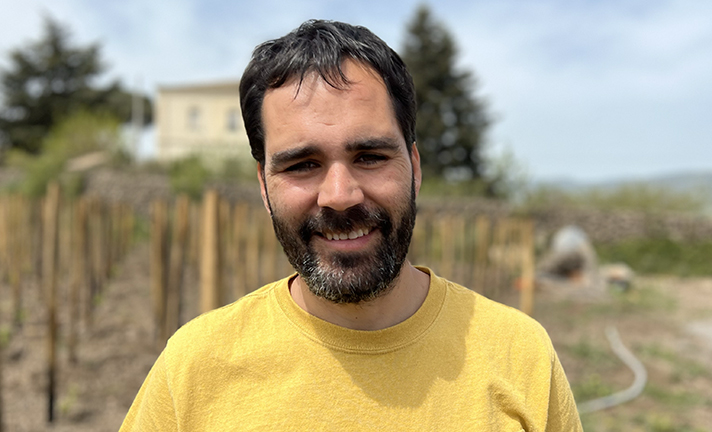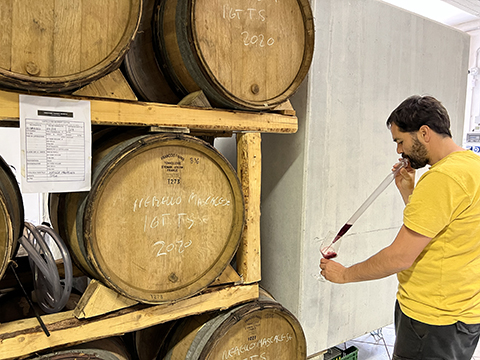Eduardo Torres Acosta grew up on Tenerife the largest of the Canary Islands, a Spanish archipelago off the coast of northwestern Africa. As a child he made wine with his father and grandfather on his family's small vineyard plot. In 2012 Eduardo moved to Sicily and worked for two of the Italy's most respected wineries, Azienda Arianna Occhipinti and Azienda Passopisciaro. Eduardo is very literally a garage winemaker, making wines from a group of eight small parcels on Etna in a garage he converted into a winery. He makes natural wines using traditional Etnaen viticulture and his vineyards are mixed plantings of various local varieties Nerello Mascalese with Nerello Cappuccio, Alicante, Garnacha, Minella, Catarratto, Grecanico, Carricante and Inzolia.
Grape Collective talks to Eduardo about this unique wine journey and the magic of making wine on Etna.
 Eduardo Torres Acosta: I arrived in Sicily in 2012. I am originally from the Canary Islands. First I studied agricultural engineering and after that I studied enology. When I was working in the Canary Islands with my parents and my grandfather we were making wine, bulk wine.
Eduardo Torres Acosta: I arrived in Sicily in 2012. I am originally from the Canary Islands. First I studied agricultural engineering and after that I studied enology. When I was working in the Canary Islands with my parents and my grandfather we were making wine, bulk wine.
When I was studying I was looking forward to learning in other regions. When I was studying enology, my friend, producer Roberto Santana from Envinate recommended I come to Sicily to the Occhipinti area. I stayed here for one vintage in 2012 and met Etna. Since that year I wanted to come and make a vintage in Etna to learn the terroir, to learn the varieties and find some common points between the Canary Islands and Etna which are both volcanic.
And so in 2013 I was looking for a winery where I could make some vintages. Franchetti, the company Passopisciaro di Vini Franchetti, offered me to be an enologist in 2013. I started to look for vines to cultivate and learn a little bit more. With him I have learned many things about the contrade, different vineyards, and that is the reason why I am here.
I think the thing that made me come here to Etna is the volcano, that it is currently an active volcano. The soil. The possibility to cultivate in high altitudes and small parcels. For example going from 500 meters to 1,000 meters, that can take usually 10 or twenty minutes in a car, and you can see the differences that we find in the different zones in Etna. When you go to different areas you find different microclimates, change of climate and change of rain, change of wind, change of many things. And me personally I like the idea of having all these vineyards that I work in different zones, because every vineyard conveys a different idea. In other zones where the territory is larger, much bigger, you don’t find these differences.
In Etna, many people from abroad come to visit. Etna is a place where people come to visit in the Mediterranean; there is the sea, there is the sun, there is the beautiful temperature. And this particular part of Sicily has the volcano. I think the winemakers Frank Cornelissen, Marco de Grazia, Franchetti, they are not originally from Sicily. It was around 2001 when it was a zone that was very distressed.
There were many big wineries that were here before such as Benanti and Calabretta, and they were close to the north zone, the homeland. But there was no movement here and the terroir was abandoned, because in general there was no value for the grapes. So when people who are from the wine world arrived, they found the type of soil and the different varieties from here that are autochthonous varieties, they are old vines, and a traditional system of growing. They fell in love with this place, like I did when I arrived in 2012 on Etna. Very quickly I wanted to come and make wine. What was most interesting for me was to know a volcanic terroir that is like the Canary Islands.
I believe that the union of everything has always been the vineyard, especially in a place that is so spectacular like Etna, where there is a soil that is very unique and is not always the same. For example, in the Canary Islands the volcanic soil changes a lot depending on where you are. The soil in the Canary Islands is very similar but there are many soils that are totally different. I was attracted to the beauty and the polyculture of the vineyards because there are many different plants, unlike many other places in Italy that are monoculture. I tried to learn and really know other terroirs.
 For me the techniques that we use are also very important when we choose a place to make wine. The ancient palmento is very similar to what we have on the Canary Islands, the system is the same. The difference is that the Canary Islands use parts of the pine tree and here on Etna they use the palmento with the volcanic stone.
For me the techniques that we use are also very important when we choose a place to make wine. The ancient palmento is very similar to what we have on the Canary Islands, the system is the same. The difference is that the Canary Islands use parts of the pine tree and here on Etna they use the palmento with the volcanic stone.
One of the things that I liked when I arrived was the traditional cultivation system. There is the alberello, which is a system of cultivation that we have only seen here in Sicily, in Etna, but also in other places in Sicily where we find more old vines with an alberello with a chestnut pole. You can only find this chestnut pole here on Etna. There are other places like Noto where they have a traditional system. The alberello caught my attention a lot.
Also the Canary Islands have been Portuguese, Genovese and Spanish, so that has been very influential to our winemaking. The only thing is that there in the Canary Islands the system is more archaic and here they are more professional. Professional in the sense that you see the ancient palmento, where there is the window, where the grapes enter, and where there is one processing per level.
There was a little influence from the French, and influence also of Northern Italy, this is the influence that was in Sicily. Also with regards to the terroir of this northern area that more or less goes from between Randazzo and Linguaglossa where we are, there is an area canal that is affected, depending on where the wind is coming from. In the north, the wind normally comes more from the west, but it’s a fresher wind when it comes from the southeast.
There are soils, which have been created over millions of years, many years, many eruptions, which are soils that come from the the pyroclastic eruption where the volcanic ashes were transported with the wind and they moved and covered a whole part of the territory which is the one we can work on. There are areas where stones are solid and they are very difficult and it is not possible to cultivate. The soils change depending on the area. For example Allegracuore, they are very fine soils, they are deep soils that produce more flowers, more fruit.
As you go up or you go for example to the part of Candelaro or go up to Sera Nuova, there are many soils with skeletons, with many stones, which produce wines that are a little more direct. Soils that have multiple species make spicier wines. Indeed this changes a lot, depending on location and altitude. For example, here the lower vineyards reach 600, 550 meters in height and the skins of the Nerello grapes are a little thicker, the tannin is a little more direct. While you go up in altitude, you also gain finesse, they are finer with more elegant skins. And that difference in height, difference in soils, makes very different terroirs in the end. So it depends where you are, even if it is always volcanic.
When I was working in the Canary Islands I was working in a traditional form, we have always been an organic culture in general.














